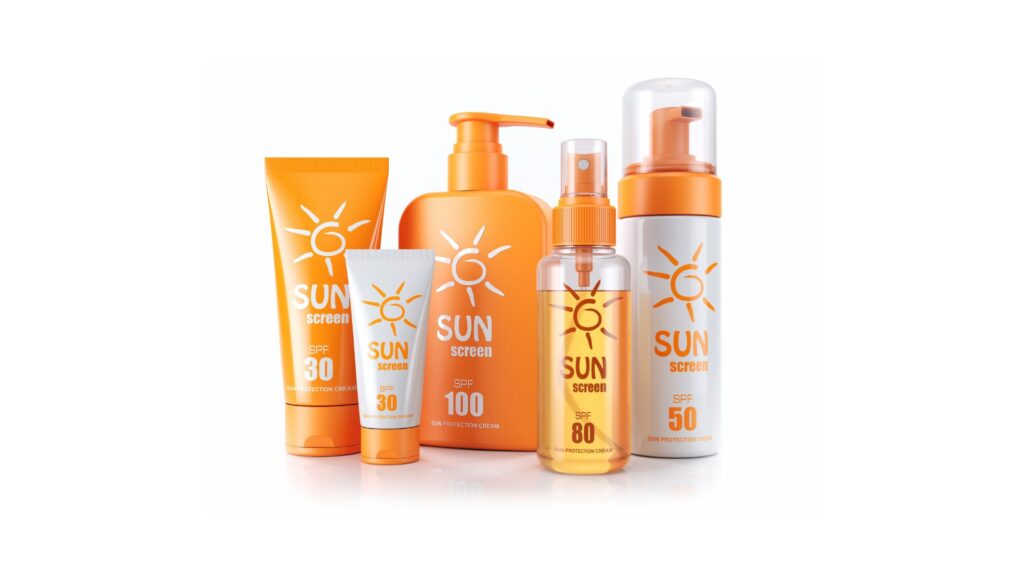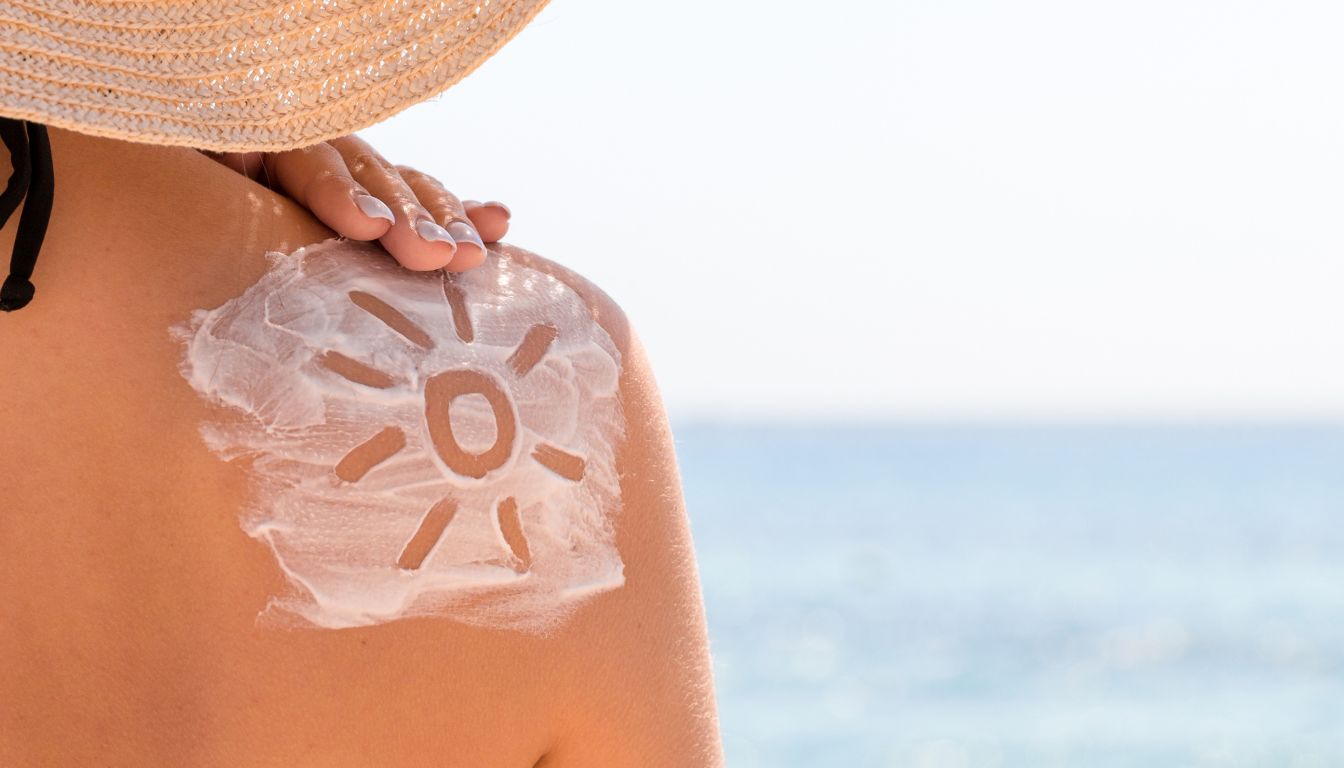Finding the right sunscreen can feel like a quest for some of us. Itchy skin, redness, or bumps after applying sunscreen? You might be dealing with a sunscreen allergy. Most people don’t realize that an ingredient meant to protect them could cause discomfort.
Here’s an important fact: The FDA regulates sunscreens to ensure they’re safe and effective. But even then, allergies occur.
This guide shines a light on what you need to know about sunscreen allergies, supplements, and medicines that offer sun protection. From understanding the causes and symptoms of sunscreen allergies to selecting the right products for your skin—we’ve got you covered.
Learn how to enjoy the sun safely without worry. Ready? Let’s get started!
Key Takeaways
- Sunscreen allergies can be caused by certain ingredients like PABA, benzophenones, and oxybenzone. Look for hypoallergenic options if you have sensitive skin.
- Dermatologists use patch testing to find out what sunscreen ingredients you might be allergic to. They can then recommend safe alternatives.
- Mineral sunscreens with zinc oxide or titanium dioxide are less likely to cause skin reactions and are better for the environment than chemical sunscreens.
- Supplements like vitamins C and E may offer some protection against sun damage when used alongside regular sunscreen application.
- Applying sunscreen correctly is key: use at least SPF 30, apply it 15 minutes before going outside, and reapply every two hours or after swimming or sweating.
Understanding Sunscreen Allergies

Sunscreen allergies can surprise you, causing itchiness and red skin after use. Experts reveal that certain chemicals or natural ingredients in sunscreen lead to these reactions.
Symptoms and Causes
Skin allergies from sunscreens can show up as rashes, itching, redness, and blistering. Sometimes people feel stinging or burning on their skin without any visible rash. These are signs that the sunscreen might not suit your skin.
Ingredients like PABA, benzophenones, cinnamates, salicylates, avobenzone, ecamsule, and ensulizole have caused reactions in some users.
The cause of these allergies often lies in the sunscreen’s ingredients – including fragrances, preservatives, oils and botanical extracts which may lead to irritant contact dermatitis.
The FDA regulates sunscreens to ensure they’re safe but reactions still happen because everyone’s skin is different.
Protecting your skin is important but knowing what’s in your sunscreen matters just as much.
Diagnostic and Treatment Options
Finding out if you’re allergic to sunscreen involves careful steps. A dermatologist can help diagnose and treat any reactions efficiently. Here’s how:
- Patch Testing: Dermatologists often start with patch testing. They apply small amounts of various sunscreen ingredients on your skin, typically on your back, and monitor the spots for reactions over a few days.
- Blood Tests: In some cases, they might suggest blood tests to identify any underlying conditions that could cause skin sensitivity or allergies to sunscreen components.
- Ingredient Elimination: You’ll be advised to avoid sunscreens containing specific ingredients known to trigger your symptoms. For example, if you’re allergic to chemical filters like avobenzone or oxybenzone, a switch to mineral-based sunscreens might be recommended.
- Prescription Medications: If the allergic reaction is severe, prescribed medications such as corticosteroids can reduce inflammation and itching.
- Topical Treatments: For milder reactions, over-the-counter hydrocortisone creams might alleviate symptoms without the need for stronger medication.
- Alternative Sun Protection Strategies: Your dermatologist may suggest using clothing with Ultraviolet Protection Factor (UPF), wide-brimmed hats, and sunglasses as extra measures against sun exposure while managing an allergy.
- Hypoallergenic Options: They will likely guide you to sunscreens labeled ‘hypoallergic’ or ‘for sensitive skin.’ These options are formulated without many common irritants.
- Skin Care Routine Adjustments: Incorporating gentle skin care products into your routine can help strengthen the skin’s barrier function, making it less susceptible to irritants found in some sunscreens.
- Regular Follow-ups: Keeping in touch with a healthcare provider ensures any adjustments needed based on how your skin responds can be made quickly.
- Educating on SPF Choices: Experts emphasize choosing broad-spectrum sunscreens with a high SPF for effective protection against both UVA and UVB rays, crucial for people with sensitivities since more frequent application of sunscreen might increase exposure to allergens.
A dermatologist’s guidance ensures that even those with sunscreen allergies can enjoy the outdoors safely, balancing effective sun protection with their unique skin care needs.
Types of Sunscreens and Their Ingredients

Sunscreen comes in many forms, each with its unique mix of ingredients. Exploring these can help you choose the best protection for your skin.
Chemical Sunscreens
Chemical sunscreens work by absorbing UV rays, transforming them into heat, and releasing them from the skin. They often contain ingredients like avobenzone, oxybenzone, octinoxate, and ecamsule.
These compounds are effective in providing broad-spectrum protection against both UVA and UVB rays. The FDA regulates these ingredients to ensure sunscreen safety and effectiveness.
Yet, some people develop allergic reactions to specific chemicals used in these products.
Individuals with sensitive skin might experience irritation or allergic responses to components found in chemical sunblocks such as PABA, benzophenones, cinnamates, salicylates, ensulizole, and ecamsule.
Reports have also mentioned concerns about certain chemicals disrupting hormones. To minimize risks of allergies or adverse effects while using sun protection products with chemical formulations it’s crucial for consumers to read labels carefully and consider hypoallergenic options recommended by dermatologists.
This is especially important for those known to have medication sensitivity or a history of sunscreen allergies when seeking effective UV protection strategies.
Mineral/Physical Sunscreens
Shifting focus from chemical sunscreens, mineral or physical sunscreens present a different approach to sun protection. These sunscreens use zinc oxide or titanium dioxide to create a barrier on the skin.
This barrier reflects UV rays away from the body, acting as a shield against harmful solar radiation. They’re known for being less likely to cause skin irritations or allergies, making them a preferred choice for sensitive skin types.
Mineral sunscreen ingredients comply with FDA regulations, ensuring their safety and effectiveness in shielding the skin from UV damage. Because of their physical block mechanism, they start working immediately upon application — unlike chemical varieties that need time to absorb into the skin.
Ideal for individuals with sunscreen allergies or those concerned about hormone disruption linked to certain chemicals in traditional sunscreens, these formulations offer broad-spectrum protection without relying on potentially problematic substances.
Primary and Secondary Sunscreens
Primary sunscreens absorb or scatter the sun’s harmful rays before they can penetrate the skin. These products often contain chemicals like avobenzone and ecamsule, known for their effectiveness against UVA and UVB rays.
Mineral-based options such as zinc oxide and titanium dioxide fall into this category too. They sit on top of the skin, reflecting sunlight away. The FDA regulates these ingredients to ensure safety and efficacy in sun protection.
Secondary sunscreens provide additional benefits beyond UV protection. Ingredients like antioxidants may be added to help neutralize free radicals generated by exposure to sunlight, potentially reducing skin damage and aging signs.
While primary sunscreens focus on direct sun defense, secondary ones enhance overall skin health during exposure.
Moving on, sunscreen safety involves understanding both benefits and risks associated with various formulations.
Sunscreen Safety and Risks
Exploring the safety and risks of sunscreen can reveal a lot. Every product has its own set of benefits, but we also need to be aware of potential side effects.
Allergy Management and Prevention
Managing allergies to sunscreen starts with identifying the specific ingredients that trigger reactions. Since the FDA regulates sunscreens for safety and effectiveness, people can look for products free from known allergens like PABA, benzophenones, cinnamates, salicylates, avobenzone, ecamsule, and ensulizole.
Opting for hypoallergic or mineral-based sunscreens can significantly reduce the risk of allergic reactions. Ingredients such as fragrances, preservatives, oils, and botanical extracts are more likely to cause irritant contact dermatitis; thus avoiding these can also help prevent adverse effects.
Consultation with a dermatologist is crucial for anyone experiencing adverse reactions to sunscreen. Health professionals can offer specific advice on selecting suitable sun protection products that offer broad-spectrum protection without compromising skin health.
They might recommend high SPF sunscreens that protect against both UVA and UVB rays but are formulated without the ingredients that typically cause sensitivity or allergic reactions.
This approach ensures effective sun protection while minimizing the risk of irritation or allergy—making safe sun exposure possible for everyone including those with sensitive skin.
Impacts on the Environment
After managing and preventing sunscreen allergies, it’s crucial to consider how sunscreens affect our planet. Some sunscreen ingredients harm coral reefs and marine life. For example, chemicals like oxybenzone and octinoxate have been found to contribute to coral bleaching when they wash off in the ocean.
Chemical sunscreens don’t just stay on our skin. They end up in the water, affecting fish and other wildlife. Mineral sunscreens are a better choice for the environment because they contain ingredients like zinc oxide or titanium dioxide that do not cause harm to marine ecosystems.
Choosing mineral-based sunscreens helps protect your skin and our oceans.
Contraindications and Safety Considerations
Not all sunscreens work well for every skin type. Some ingredients, like PABA, benzophenones, cinnamates, salicylates, avobenzone, ecamsule, and ensulizole have caused sunscreen allergies.
People with sensitive skin might react badly to fragrances, preservatives, oils, and botanical extracts found in many sun protection products. These reactions can range from mild irritations to severe allergic responses.
For individuals experiencing adverse reactions such as stinging or burning without visible rash—consulting a dermatologist is key. They may recommend avoiding certain ingredients and choosing hypoallergenic or mineral-based sunscreens instead.
It’s crucial to select broad-spectrum protection sunscreens with high SPF ratings for effective defense against both UVA and UVB rays while also considering personal sensitivities to prevent discomfort or health risks.
The Benefits and Disadvantages of Sunscreen
Sunscreen protects your skin from UV rays but can also have downsides, like reactions or environmental effects. Explore more to find the best sun protection strategy for you!
How Sunscreen Works
Sunscreen acts as a shield against the sun’s harmful UV rays, which can cause sunburn and premature aging. It does this by using chemicals or minerals to absorb, reflect, or scatter sunlight away from the skin.
Chemical ingredients like avobenzone and ecamsule grab onto UV radiation and transform it into heat, which then gets released from the skin. Mineral components such as zinc oxide and titanium dioxide create a physical barrier that reflects UV rays away.
By doing so, sunscreen helps protect against skin damage and reduces the risk of skin cancer.
Applying sunscreen correctly offers broad-spectrum protection, meaning it guards against both UVA and UVB rays. The FDA regulates these products to ensure they meet safety standards for effectively preventing sunburn and lowering the chance of premature aging.
With an appropriate SPF value—recommended to be high enough to prevent both UVA and UVB damage—sunscreen application becomes an essential part of daily skin care routine for anyone exposed to sunlight, providing safety while minimizing adverse reactions like allergies or irritant contact dermatitis caused by certain ingredients.
Pros and Cons of Common Types of Sunscreens
Choosing the right sunscreen involves weighing the benefits against the potential drawbacks. With a focus on safety, effectiveness, and individual health needs, let’s evaluate the pros and cons of common types of sunscreens.
| Type of Sunscreen | Pros | Cons |
|---|---|---|
| Chemical Sunscreens |
|
|
| Mineral/Physical Sunscreens |
|
|
| Hypoallergenic Sunscreens |
|
|
Selecting the right sunscreen is a personal decision that should take into account individual skin type, concerns about potential allergies, and lifestyle factors. Consulting with a dermatologist can provide specific advice to ensure the choice offers effective protection while minimizing risks. Always consider products regulated by the FDA to meet safety and effectiveness standards.
Selecting and Using Sunscreen
Choosing the right sunscreen means looking at SPF, UVA/UVB protection, and how water-resistant it is. Read on to find out more about making the best choice for your skin.
SPF and UVA/UVB Protection Ratings
SPF stands for Sun Protection Factor and measures how well sunscreen can protect skin from UVB rays, the kind that cause sunburn. High SPF numbers mean more protection. For UVA rays, which can prematurely age skin, broad-spectrum protection is key.
The FDA regulates these ratings to ensure they meet safety and effectiveness standards. It’s essential to pick a sunscreen with at least SPF 30 for effective skin shield against both UVA and UVB rays.
Experts recommend reapplying sunscreen every two hours or after swimming or sweating to maintain optimum protection. This habit helps safeguard against harmful effects like sunburn and premature aging of the skin.
Next up, let’s consider water resistance in sunscreens and why that matters in your selection process.
Water Resistance and Application Tips
Choosing the right sunscreen involves more than just SPF. Water resistance and proper application are key to ensuring full sun protection.
- Look for “water-resistant” labels on sunscreen products — these are designed to stay effective for 40 to 80 minutes in water.
- Apply sunscreen generously on all exposed skin at least 15 minutes before going outdoors to allow it time to absorb.
- Use a broad-spectrum sunscreen to protect against both UVA and UVB rays, aiming for an SPF of 30 or higher.
- Reapply every two hours, especially after swimming, sweating, or towel drying, even if you’re using a water-resistant product.
- Cover often-missed spots like the tops of your feet, back of your neck, and ears.
- Use a lip balm with SPF protection to safeguard your lips from sun damage.
- For best results, apply sunscreen under makeup if you won’t be wearing a protective face covering.
- Measure out the right amount — most adults need about one ounce (roughly enough to fill a shot glass) to fully cover their body.
- Opt for sunscreens free of fragrances and oils if you have sensitive skin or allergies to certain ingredients.
- Check the expiration date on your sunscreen bottle; expired products can lose effectiveness and may not provide adequate protection.
Following these tips will help ensure that your skin is fully protected from harmful UV rays while enjoying time outdoors.
Other Factors to Consider
Exploring sunscreen isn’t just about SPF levels—factors like systemic absorption and the role of nanoparticles demand our attention too. Keep reading to discover more!
Systemic Absorption of Chemical Sunscreens
Chemical sunscreens work by absorbing UV rays before they can damage your skin. Yet, some of their active ingredients can enter the bloodstream. Studies led by the FDA have shown this absorption happens, but more research is needed to understand if it poses any health risks.
Common chemicals like avobenzone, ecamsule, and ensulizole are examples that get absorbed.
Despite this absorption, chemical sunscreens play a crucial role in skin cancer prevention and protecting against premature aging caused by the sun. The FDA continues to regulate these products to ensure they meet safety standards.
It’s recommended to use broad-spectrum protection with a high SPF to guard against UVA and UVB rays effectively while monitoring for any adverse reactions or allergies related to specific ingredients.
Nanoparticles and Vitamin D
Nanoparticles in sunscreens, especially those found in mineral-based formulas like zinc oxide and titanium dioxide, provide strong UV protection. These tiny particles create a barrier that reflects sunlight away from the skin.
The use of nanoparticles has raised concerns about their ability to penetrate the skin and potentially cause harm. Yet, research shows these particles stay on the outermost layer of the skin, posing minimal risk.
Vitamin D synthesis is critical for bone health and immune function and is naturally triggered by sun exposure. Sunscreen plays a vital role in blocking harmful UV rays but can also reduce Vitamin D production if used extensively.
Balancing sun protection with adequate Vitamin D levels requires sensible sun exposure—experts suggest short, frequent periods outdoors without sunscreen can help maintain healthy Vitamin D levels while minimizing skin cancer risks.
Alternative Sun Protection Methods
Certain supplements offer additional sun protection. For example, antioxidants like vitamins C and E can fight free radicals from UV exposure, reducing sun damage. Polypodium leucotomos, a fern extract used in some oral supplements, has shown promise in enhancing the skin’s resistance to sunburn.
Consulting a healthcare professional is crucial before starting any new supplement for sun defense. They can provide guidance based on individual health needs and ensure that the chosen products complement existing sun safety measures like sunscreen use and protective clothing.
This personalized approach helps maximize protection against harmful UV rays while minimizing the risk of adverse reactions or interactions with other medications.
Conclusion
Exploring sunscreens, allergies, and alternatives reveals a vast landscape of options and considerations. Dr. Emily Tanaka stands at the forefront of this field, armed with over two decades in dermatology.
Her journey began with a biology degree from Stanford University, leading to an M.D. from Harvard Medical School. She’s significantly contributed to groundbreaking sunscreen research and championed public education on skin health.
Dr. Tanaka evaluates that sunscreens play a crucial part in preventing skin damage but cautions against overlooking potential allergens within these products. Her analysis leans heavily on understanding the chemical versus mineral bases—each serving unique roles in UV protection while posing distinct risks for sensitive individuals.
Safety isn’t just about avoiding burns or rashes; it spans ethical sourcing and transparent labeling of ingredients—a stance Dr. Tanaka firmly supports. She advocates for stringent FDA oversight and clearer communication from brands about what’s inside their bottles.
Incorporating sun protection into daily routines doesn’t have to be complex. Dr. Tanaka suggests looking beyond creams to hats, clothing, and even diet changes for a more holistic approach to UV defense.
Weighing pros against cons reveals no perfect solution; each product serves different needs yet might fall short under certain conditions or sensitivities—a balance she urges consumers to consider thoughtfully.
Ultimately, Dr. Tanaka champions informed choice above all—understanding individual skin types, acknowledging potential irritants, and considering environmental impacts guide her positive outlook on current sunscreen offerings and future innovations alike.
Empowered by knowledge and vigilant about personal health needs, anyone can find suitable sun protection methods—that’s the essence of her final verdict on approaching this vital aspect of skincare responsibly.
FAQs
1. What causes sunscreen allergies?
Certain chemicals in sunscreens can trigger allergic reactions in some people.
2. How do I know if I’m allergic to my sunscreen?
If you get a rash, itchiness, or redness after applying sunscreen, you might be allergic.
3. Can taking certain supplements help with my sunscreen allergy?
Yes, some supplements like omega-3 fatty acids and vitamin E can support skin health and may reduce sensitivity.
4. Are there any medicines that can treat a sunscreen allergy?
Over-the-counter antihistamines and topical steroids can relieve symptoms of a mild sunscreen allergy.
5. Is it possible to find a sunscreen that won’t cause an allergic reaction?
Yes, look for sunscreens labeled “for sensitive skin” or those containing physical blockers like zinc oxide or titanium dioxide.
General Facts
- FDA regulates sunscreens to ensure they meet safety and effectiveness standards.
- Sunscreens are used to protect the skin from the harmful effects of the sun, such as preventing sunburn and premature aging.
- Some sunscreen ingredients have been reported to cause skin allergies and disrupt hormones.
- Sunscreen allergy has been reported with individual sunscreen agents including PABA, benzophenones, cinnamates, salicylates, avobenzone, ecamsule, and ensulizole.
- Fragrances, preservatives, oils, and botanical extracts are common sunscreen ingredients that can cause irritant contact dermatitis.
- Adverse reactions to sunscreens may include subjective irritation such as stinging and burning without a rash.
- There are myths about sunscreen effectiveness and claims that it may cause skin cancer, but these claims are not supported by scientific evidence.
- It is important to choose sunscreens that offer broad-spectrum protection and have a high SPF (sun protection factor) to protect against both UVA and UVB rays.
- Individuals with sunscreen allergies may need to avoid specific sunscreen ingredients and opt for hypoallergenic or mineral-based sunscreens.
- It is essential to consult a dermatologist or healthcare professional if experiencing adverse reactions to sunscreens or sunscreen allergies.
Source URLs
- Sunscreen: How to Help Protect Your Skin from the Sun – FDA: FDA
- Sunscreen Use and Details – WebMD: WebMD
- 8 Little-Known Facts About Sunscreens – EWG: EWG
- Topical Sunscreen Agents – DermNet NZ: DermNet NZ
- Safety and Effectiveness of Sunscreen – New York Times: New York Times
- Insights into Sunscreen Research – NCBI: NCBI
- The Science of Sunscreen – Harvard Health: Harvard Health

